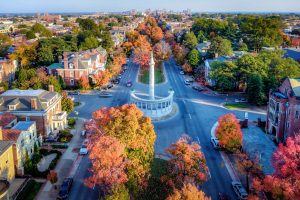“Richmond may not be the first destination that comes to mind for fall, but that’s exactly what makes it so special,” said Katherine O’Donnell, President and CEO of Richmond Region Tourism. “Our mix of historical sites, outdoor beauty, and exciting seasonal experiences makes the Richmond Region an ideal getaway for anyone looking for an authentic, unexpected fall escape.”
Here are some of the top reasons to visit this under-the-radar fall destination:
Fall Colors in the Heart of Virginia
When it comes to jaw-dropping scenery, the Richmond Region puts on a spectacular show. Local parks like Pocahontas State Park in Chesterfield County and Taylor Farm Park in Henrico County feature trails and picnic pavilions where visitors can hike, bike, or simply soak in the stunning colors of autumn.
History and Haunts: Spooky Tales From Richmond’s Past
Tours of Hollywood Cemetery (pictured above) offer a hauntingly beautiful exploration of the final resting places of some of Virginia’s most notable figures, including two U.S. presidents. Meanwhile, ghost tours throughout the region dive into Richmond’s eeriest locations, from Shockoe Bottom’s storied streets to Church Hill’s haunted houses.
 Chills and Thrills at Kings Dominion
Chills and Thrills at Kings Dominion
For thrill-seekers, Kings Dominion transforms into a haven of terror during the fall season. Halloween Haunt takes over select nights from late September through early November, offering haunted mazes, scare zones, and live shows for visitors who want a mix of amusement park fun and spine-tingling horror. Families looking for something more kid-friendly can opt for Tricks and Treats and enjoy festive activities, fall-themed entertainment, and plenty of candy.
 Spooky Lights Tours: A Halloween Twist on a Local Tradition
Spooky Lights Tours: A Halloween Twist on a Local Tradition
Richmond’s renowned Tacky Light Tours get a spooky makeover during the Halloween season with Spooky Lights Tours, where families can enjoy the best-decorated homes and front yards dressed up for Halloween (pictured above).
The Poe Museum: Commemorating America’s Master of Macabre
The Edgar Allan Poe Museum is an essential stop for any fan of America’s greatest writer of dark tales. With special programming during the fall season and the largest collection of Poe memorabilia in the world, the museum offers visitors a glimpse into the poet’s life, works, and the mysterious allure that surrounds his legacy.
Enchanting Evenings at Maymont
Maymont is host to Garden Glow presented by Kroger, where guests can explore the gardens illuminated with vibrant colors and creative light displays. This family-friendly event runs from mid-October through early November and offers a stunning contrast to the darker, spookier side of many of the region’s fall events.
Whether you’re seeking a hidden gem for fall foliage, under-the-radar spooky destinations, or wholesome, family-friendly Halloween fun, the Richmond Region offers something fresh and unexpected for all visitors. From scenic parks and eerie cemeteries to literary landmarks and dazzling light displays, it’s easy to see how Richmond’s fall season speaks for itself.
Start planning your 2024 fall getaway to the Richmond Region at VisitRichmondVA.com.
 Extended Weekend Getaways
Extended Weekend Getaways 